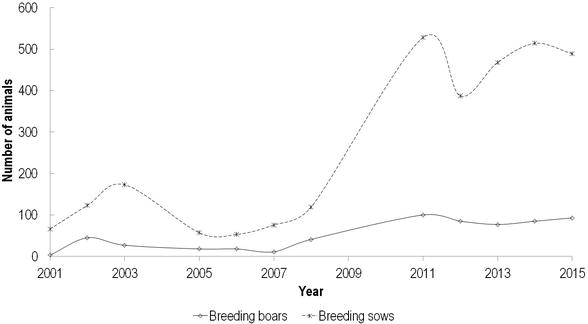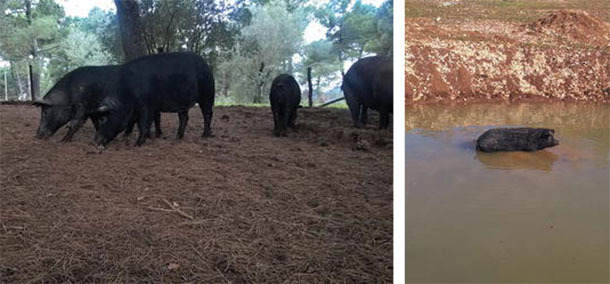History and the current status of the breed
The Apulo-Calabrese is a breed of black domestic pig from Calabria, in Southern Italy. Census of the Apulo-Calabrese pig breed is presented in Figure 1. Presently, there are 45 registered farms of Apulo-Calabrese pigs with about 489 breeding sows and 93 boars in the latest available status (August 2015). From the historical point of view, already in pre-Roman times, the migratory flows from Central Italy to the South favoured the spread of pig breeding along the Apennine ridges. The Apulo-Calabrese breed is, therefore, a swine population that has been established over the centuries and has spread with the transhumance of the flocks on the road routes dating back to Roman times. In the past century, black coat pigs, capable of using poor food resources, were present along the Apennine foothills. The abandonment of the lands and the uncontrolled introduction of cosmopolitan breeds provoked a rapid decline of this breed too, until, eventually in the 1990s, a recovery action started. The conservation programme has progressively been consolidated, and the herd book was established in 2001.


Exterior phenotypic characteristics
The Apulo-Calabrese pig breed morphology information is summarised in Table 1. It is medium- to small-sized breed with plain black coat colour (Figures 2 and 3). The bristles are black, straight, robust and longer in the dorsal region even if white spots on the lower extremities of the legs are allowed. Long and thin snout with a straight head profile, droopy ears projected forwards and a straight tail. Not less than ten nipples normal and well pronounced.
Table 1. Summary of morphology information on Apulo-Calabrese pig breed.
| Measurement (average) | Adult male | Adult female |
|---|---|---|
| Body weight (kg) | 150 | 130 |
| Body length1 (cm) | 130–145 | 130–142 |
| Height at withers (cm) | 72–82 | 71–79 |
| Number of teats | 13 | 13 |
1Measured from the tip of the nose to the starting point of the tail.

Geographical location and production system
The Apulo-Calabrese breed is present in the southern regions of Italy with the primary concentration of herds in Calabria, Basilicata and Lazio. The breed has been recovered by a regional agricultural development company, which had kept a few animals in a structure located in the municipality of Acri in the province of Cosenza. A not insignificant quantity of Calabrian black pigs was always present in the area of Polsi (Aspromonte) where it is still grazed-free, fed mainly with acorns and chestnuts. Currently, the breed has a recovery, albeit slow, thanks to some small Calabrian pig farms, mostly family-run, with the relative production of its precious sausages. The breed is maintained mainly by peasant farming system using the agroforestry practices. Most of the animals are kept continuously confined, and the basic heat protections are available even if the housing parts are not completely climate controlled.
Productive performance
Reproductive traits
The average age of sows at the first parturition varies from 13 to 23.5 months of age, whereas, according to ANAS heard book data, age at culling is 52.3 months. Sows of Apulo-Calabrese pig breed have 1.2–2.2 litters per year with 6.1–8.0 piglets of approximately 1.0 kg live body weight. Stillborn percentage of piglets varies from 6.2 to 7.1%, whereas piglet mortality rate until weaning in the considered studies ranged from 8.6 to 20.8%. Duration of lactation is prolonged in comparison to modern intensive systems (to 40 days), which leads to a longer farrowing interval (171–300 days) but variable piglet weaning weight (3.4–8.1 kg).
Growth performance
Due to big differences between studies with regard to the live weight range covered, we defined the stages for growth performance as lactation (regardless of how long it was), growing stage (from weaning to approximately 30 kg live body weight) and early, middle and late fattening stages estimated between approximately 30 and 60 kg, 60 and 100 kg and above 100 kg live body weight, respectively.
In the considered studies, a daily gain in the early growing stage that corresponds to lactation period varied from 134 to 155 g/day. The average daily gain in growing stage was approximately 280 g/day, whereas in overall fattening stage, it ranges from 300 to 706 g/day.

Body composition and carcass traits
Pigs of the Apulo-Calabrese breed were slaughtered at approximately 336 days of age and 149 or 175 kg live weight. Approximately 81.1% dressing yield and only 44.8% lean meat content (SEUROP classification) is reported. Accordingly, relatively high backfat thickness of 68 mm at the withers and 48 mm at the level of the last rib was measured.
Meat and fat quality
Data on meat and fat quality in Apulo-Calabrese pigs are missing, the only information found was measurements of pH in longissimus muscle. The pH at 45 min and 24 h post-mortem were 6.30 and 5.85, respectively, measured in 40 animals slaughtered at 149 kg.
Use of breed and main products
Apulo-Calabrese pigs are used to enhance poor food showing rusticity and adaptability to grazing, with the good maternal ability for the sow. This breed of pigs adapts very well to outdoor breeding both with extensive and semi-extensive systems, feeding on acorns, chestnuts, tubers and roots that can be found in the wooden areas where it is bred. The breed is currently fully market-oriented interesting both regional and national markets. The most famous product derived from Apulo-Calabrese is the “soppressata” which derives from the meat of the ham and shoulder, the “capocollo” obtained from the top of the boned loin and with a layer of about 3–4 mm of fat and the lard derived from the dorsal part. Other relevant products are the black pudding mixed with chocolate and the “nduja of Spilinga”, an exceptional type of soft spread and very spicy salami.
Full text and references are available here: Apulo-Calabrese pig.
Riccardo Bozzi, Maurizio Gallo, Claudia Geraci, Luca Fontanesi and Nina Batorek-Lukač (February 6th 2019). Apulo-Calabrese Pig, European Local Pig Breeds - Diversity and Performance. A study of project TREASURE, Marjeta Candek-Potokar and Rosa M. Nieto Linan, IntechOpen, DOI: 10.5772/intechopen.83760. Available from: https://www.intechopen.com/books/european-local-pig-breeds-diversity-and-performance-a-study-of-project-treasure/apulo-calabrese-pig



